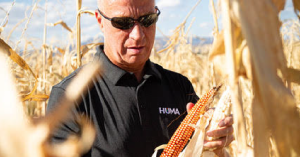With Larry Cooper

Jason Garcia
Vegetable growers in Central Florida are preparing to get their beds ready for planting, so here’s my guide to how Huma Gro® can help growers get their best vegetable crops ever.
Bed Preparation
It’s become a pretty standard practice for Florida vegetable growers to fumigate their fields, then put down plastic and drip tape as their first steps in preparing planting beds for vegetables. Fumigation is generally considered to be a necessary—though expensive and sometimes controversial—first step to protect the coming crop from soil disease and nematode damage. Fumigation can be the most expensive part of vegetable production, and it comes with a host of safety precautions and restrictions that are a challenge for the grower and the surrounding community. But there is a Huma Gro® alternative that is much safer, has no restrictions, and can be up to half the cost of fumigation.
Huma Gro® Promax® is an organic, OMRI-Listed fungicide/nematicide that can be applied through irrigation with no mandatory safety restrictions involved. You can put out a half-gallon per acre through the drip (1 gallon per acre broadcast) 2 weeks prior to planting to get the soil protection going by knocking down the microorganisms in the soil, and follow up 2 weeks later with a half-gallon of Zap® to rebuild a healthier, more diverse soil microbial community that will actually benefit the crop.
We repeat this irrigation application cycle throughout the growing season—alternating Promax® and Zap® every 2 weeks—to keep soil-borne diseases and nematodes at bay. We’ve all seen how fumigation can wear off in the middle of a growing season, and yields can take a hit at that point. There’s nothing a grower can do about it with more fumigation, because you can’t fumigate a live crop. But a continuous cycle of Promax® and Zap® through the irrigation will control nematodes and soil disease throughout the growing season to give you the best yields possible.
One of the best benefits for our region is that the application of Promax®/Zap® is not influenced by the weather. Last year we had a lot of rain just before strawberry-planting time and growers who were still dependent on fumigation were delayed with planting because they couldn’t fumigate in the wet soil (see 9-5-2019 blog). Growers using Promax®/Zap® were able to stay on schedule because they could put out Promax®/Zap® with irrigation, even in the wet fields, and the products did their job to ensure a safe planting.
Now, if you are really tied to the idea of fumigation, you can still use Promax®/Zap® throughout the season after fumigation to prevent that mid-to-end-season dip when the fumigation wears off. But many of our growers have found that Promax®/Zap® can completely replace fumigation, saving them money and still producing great crops.
Planting
Most growers have a preferred N-P-K mix that they apply, and we’re fine with that. However, if you want a high-quality crop with great yield, you need to ensure that your vegetables are getting the exact nutrients and stimulants they need exactly when they need it. This means you are going to have to manage your nutrition program a little more precisely after your basic N-P-K is applied, and Huma Gro® offers a host of options to help you do that.
With vegetables, we are usually talking about starting with plugs rather than seeds. If you are concerned that your plugs may be bringing some disease in with them, you can prepare a tray dip with Promax® or our Proud 3® product, which is a foliar-applied broad-spectrum OMRI-Listed organic insecticide-miticide-fungicide.
If you applied Promax® 2 weeks prior to planting, then at planting is the time to do the first application of Zap® through the irrigation. Consider adding 1 quart/acre of Breakout® to get the roots started and 1 quart/acre of Super Phos® for extra instantly bioavailable phosphorus to give the plant the energy it needs to take off. Some other irrigation options at planting—depending on market prices, your budget, and your crop goals—might include Huma Gro® Calcium to support early root growth and viability, Max Pak® to provide micronutrients necessary for plant vigor and resistance to environmental stress, and/or Start-L® to reduce transplant shock.
Post-Transplant Through Harvest
Foliar applications can begin about 14 days after planting the plugs. We’re going to keep the Promax®/Zap® cycle going through the drip every two weeks, but now we’re adding in the foliar applications to really get the plants moving toward where we want them to be at harvest.
The foliar program involves very small amounts of product, but you will be amazed at what these small amounts of product with our Micro Carbon Technology® can do to move the crop. Throughout the rest of the season, we recommend 1 pint/acre every week of each of the following: Breakout®, Huma Gro® Calcium, and Vitol® (for vegetative growth, energy, and fruit sizing). Twice a month add into the foliar mix 1 pint/acre of Max Pak®.
Depending on crop need, you may want to consider periodically adding 1 pint/acre of foliar Super Phos® to keep the crop’s energy up. At full fruit sizing, you might want to pull out Super Phos® and add in Super Potassium®.
Creating Your Own Program
The basic nutrition program for vegetable growing that we’ve recommended here comes down to 6 main products: Promax® and Zap® at one-half gallon per acre alternating every 2 weeks through irrigation from preplant to harvest to replace or supplement soil fumigation, and foliar application of 1 pint/acre each of Vitol®, Breakout®, and Calcium every week plus foliar application of 1 pint/acre every 2 weeks of Max Pak®.
The other products mentioned are dependent on your particular crop needs, what you want to accomplish with the crop at specific growth stages, and how the crop market is doing. Do you want to increase brix, flavor, or shelf life? Do you want to push more flowers and more fruit? Do you want to slow down flowering and go for more fruit sizing? Do you need a stronger plant? Do you need to cope with pest or other environmental stresses? We have solutions for all your growing needs. Give us a call: 1.480.961.1220.
Look for Jason’s next blog post on melons, coming soon!
Jason Garcia was born and raised in Plant City, Fla., where he grew up on a farm before he became involved in the technical aspects of farming. An agronomist and Huma Gro® Regional Manager, Jason has 25+ years helping growers improve their crops. Contact Jason at jason@humagro.com.
Huma Gro® products with Micro Carbon Technology® rapidly deliver essential nutrition to crops for optimal growth, fruiting, and vigor. The results are higher quality harvests, increased crop yields, and maximum profit.
Huma Gro® Products Mentioned:
- Promax®—product technical bulletin.
- Zap®—product technical bulletin.
- Proud 3®—product technical bulletin.
- Breakout®—product technical bulletin.
- Super Phos®—product technical bulletin.
- Calcium—product technical bulletin.
- Max-Pak®—product technical bulletin.
- Start-L®—product technical bulletin.
- Vitol®—product technical bulletin.
- Super Potassium®—product technical bulletin.
Related Posts

This Week in Ag #50
When explaining the carbon offset market, many of you have heard me give the example of companies and individuals purchasing carbon credits to “offset” their carbon footprints. By nature of what they do, some businesses such as airlines have no choice, as they’ll otherwise never come close to meeting self-imposed carbon footprint targets.

This Week in Ag #59
“It won’t grow in the bag.” Grandpa never minced words. And that’s how he responded (in frustration) to my dad and uncle whenever they pondered dropping the planter. His philosophy was simple: the moment you can plant, you plant. There’s only so much heat and sunlight Mother Nature offers, so you better take her up on

The Bearing That Broke the Farmer’s Back
Equipment breakdowns have always been part of farming, but today, the repair bills and downtime can feel unbearable. With parts prices soaring, dealer labor rates climbing, and right-to-repair battles heating up, farmers are feeling the squeeze every time a machine quits.

